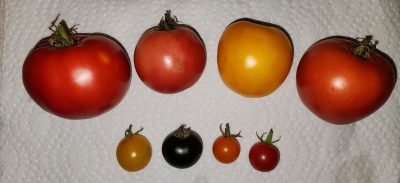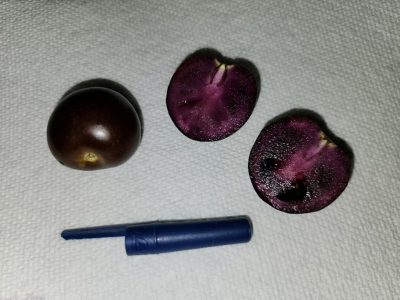By Dr. Matthew Lisy, UConn Adjunct Faculty
UConn Home & Garden Education Center

Tomatoes are one of the most popular food plants in the world, and as such, have undergone massive amounts of selective breeding. Native to western South America, the tomato can now be found all over the world. Originally grown for ornamental purposes due to fear of toxicity, modern gardeners grow many different colors including red, yellow, pink, orange, and white.
Tomatoes are prone to certain diseases which led to dependence on chemicals to control either the disease or the pest that transmits it. Disease resistant varieties of tomatoes were made by crossing certain parental tomatoes that had beneficial traits. For example, if a certain tomato tasted great but was prone to some type of wilt disease, it was crossed with a tomato that was resistant to wilt. Of course, this was VERY time consuming, and many times the final product is not perfect, but as close to ideal as possible. This does make people dependent on the seed producers, but at least you get the tomatoes you desire.
People were sad that they could never get the old heirloom varieties with superior taste to grow in the presence of modern-day diseases, so science came up with another solution – grafted tomatoes. Using young plants, the grower would take and graft the top of the desired tomato onto the roots of the undesirable but disease resistant rootstock. Certainly, these types of tomatoes have an important role in agriculture, but they are not feasible/economical in many situations.
One modern scientific solution is genetic engineering. This process takes a gene, or piece of DNA that codes for a specific trait, out of one species, and places it into another. The public generally does not like this type of technology partially due to a lack of understanding of the process, but also a fear of what could happen because of it. While science continues to make new GMOs, many companies will not use them due to consumer preference. In 1994, the “Flavr Savr” tomato became the first genetically engineered food to be granted a license for human consumption by the FDA. Although flavorful throughout its long shelf life, this tomato failed to meet commercial standards due to being easily damaged during harvest and shipping. Even though this tomato failed to become the success the company had hoped for, Calgene (now owned by Monsanto) made history.

Thirty years later, the year 2024 saw another milestone in the world of GMO tomatoes. Norfolk Plant Sciences, and its seed-selling subsidiary, Norfolk Healthy Produce, produced the first tomato with completely purple skin and flesh. This is also the first time a GMO food crop has been approved for home gardeners. The color comes from the anthocyanin pigment, which is said to have heart-healthy and antioxidant benefits when consumed in the quantity found in this tomato. In addition, this pigment may increase the shelf life of the tomato. The gene for this pigment came from edible snapdragon flowers.
Many times, people fear GMOs saying that it is unnatural to have an extra “foreign” gene in an organism, and the potential risk of a “new combination of genes” created by this engineering process. The Food and Drug Administration deems this tomato as safe for human consumption as any other. In the end, each person should do their own research and make an informed decision for themselves and their family. For me, it is an exciting time to be alive as we are living through history. I felt really excited to grow the first-ever GMO tomato for home gardeners. One day, many of the tomatoes will be like this, but for right now, I will marvel at the original.
For your gardening questions, feel free to contact us, toll-free, at the UConn Home & Garden Education Center at (877) 486-6271, visit our website at www.homegarden.cahnr.uconn.edu or contact your local Cooperative Extension center.